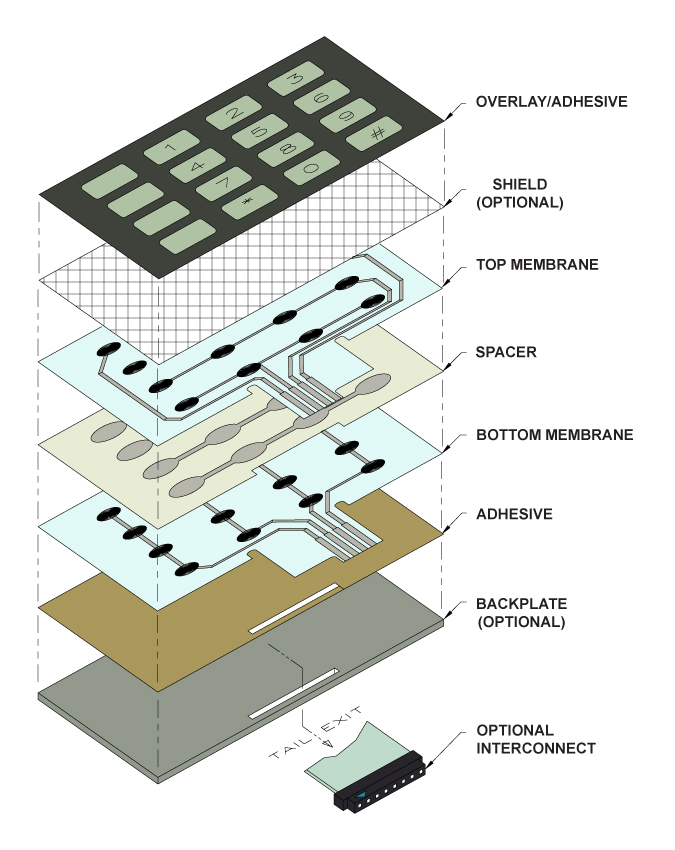How a Membrane Switch Improves User Experience and Gadget Effectiveness
Comprehending the Performance of Membrane Changes for Individual Interface Tools
The capability of membrane layer switches stands for a considerable development in individual interface layout, combining effectiveness with visual versatility. These buttons operate through a multi-layered structure that equates user interactions into electrical signals, permitting both compact formats and resilience against ecological factors. As industries significantly focus on user experience, comprehending the subtleties of membrane layer switch innovation becomes essential. What effects do these innovations hold for future applications, and just how might they redefine user interactions throughout numerous gadgets?
What Are Membrane Layer Switches?
Membrane buttons are innovative user interface gadgets that promote individual communication with electronic devices. These functional parts contain numerous layers, including a graphic overlay, spacer, and a published circuit layer. The layout permits for a seamless combination into numerous electronic gadgets, improving both the aesthetic and functional elements of interface.
Membrane layer switches are generally used in a large range of applications, from family home appliances to commercial machinery and medical devices. Their construction commonly includes a slim account, making them an optimal option for small layouts. The tactile feedback offered by these switches can be crafted to meet certain user choices, making certain reliable interaction in between the customer and the device.
Longevity is another significant benefit of membrane layer buttons, as they are immune to dirt, moisture, and chemicals, which improves their life-span in demanding environments. Additionally, these switches can be customized in regards to form, dimension, and graphic design, enabling branding and user-specific functions. In general, membrane layer switches represent a functional remedy for enhancing individual experience in electronic gadgets, incorporating capability with aesthetic allure in a reliable fashion.
How Membrane Layer Changes Work
Operating on an uncomplicated concept, membrane layer switches make use of a layered building to register user input properly. Each switch contains multiple layers, including a published circuit layer, a spacer layer, and a leading graphic layer, which are made to collaborate perfectly. When an individual presses the top layer, it compresses the spacer layer, bringing the conductive elements of the circuit layer right into contact with each various other.
This get in touch with develops a closed circuit, signifying the gadget to implement a specific feature. The style permits various arrangements, including responsive comments, which can boost the customer experience by offering a physical sensation upon activation. The materials utilized in membrane switches frequently consist of flexible substratums, such as polyester or polycarbonate, which guarantee sturdiness and strength against wear and tear.

Key Benefits of Membrane Switches

Another considerable advantage is their density. Membrane layer buttons are thin and lightweight, which allows producers to save area in their tools without sacrificing functionality. This feature is particularly beneficial in applications where weight and quantity are important factors to consider.
In addition, membrane layer switches are resistant to dirt, moisture, and chemicals, improving their longevity. This strength extends their life-span and reduces the requirement for constant substitutes, resulting in expense financial savings gradually.
In addition, the responsive responses supplied by membrane layer switches can be maximized to enhance user communication. They can include attributes such as elevated buttons or audible clicks, improving functionality and Look At This user experience.
Applications Across Industries
Interface devices making use of membrane buttons are widespread in a vast variety of sectors, showcasing their flexibility and functionality. Membrane Switch. In the clinical sector, membrane buttons are integral to devices such as diagnostic devices and client tracking systems, where their durability and convenience of cleansing are critical for maintaining health criteria. In the auto market, these buttons are employed in control panel controls and infotainment systems, supplying a smooth and modern-day user interface for customers.
Additionally, the customer electronics market advantages from membrane layer switches in devices and handheld tools, where small design and easy to use interfaces enhance user experience. Industrial applications also utilize membrane changes for control panels in machinery and automation systems, highlighting their toughness and resistance to extreme atmospheres.
In the aerospace and defense industries, membrane layer buttons are used in cabin controls and devices, where integrity and efficiency under extreme conditions are paramount. Furthermore, the video gaming market increasingly includes membrane layer switches in controllers and gallery makers, contributing to an appealing user experience. Overall, the versatility of membrane layer changes enables their prevalent use throughout many industries, underscoring their relevance in contemporary interface style.
Future Trends in Membrane Layer Switch Modern Technology

Furthermore, the usage of advanced materials, such as polycarbonate and polyester films, visit site is anticipated to climb, supplying boosted toughness and resistance to environmental stressors. These products add to the overall longevity of membrane buttons, making them ideal for harsher industrial applications.
Additionally, the incorporation of wise modern technology, including IoT connection, will allow membrane layer switches to communicate with other gadgets and systems, helping with an extra interactive customer experience. This fad straightens with the expanding need for clever tools throughout numerous industries, from healthcare to consumer electronics.
Lastly, customization options are anticipated to expand, allowing suppliers to develop bespoke remedies customized to details user demands and choices. These advancements will place membrane layer buttons as crucial parts in the development of individual interface innovation.
Conclusion
In conclusion, membrane layer switches over represent a crucial development in customer interface innovation, supplying a reputable and functional option for diverse electronic applications. As innovations in material scientific research and touch noticing innovations continue, the capability and applicability of membrane switches are anticipated to expand, strengthening their value in modern electronic devices.